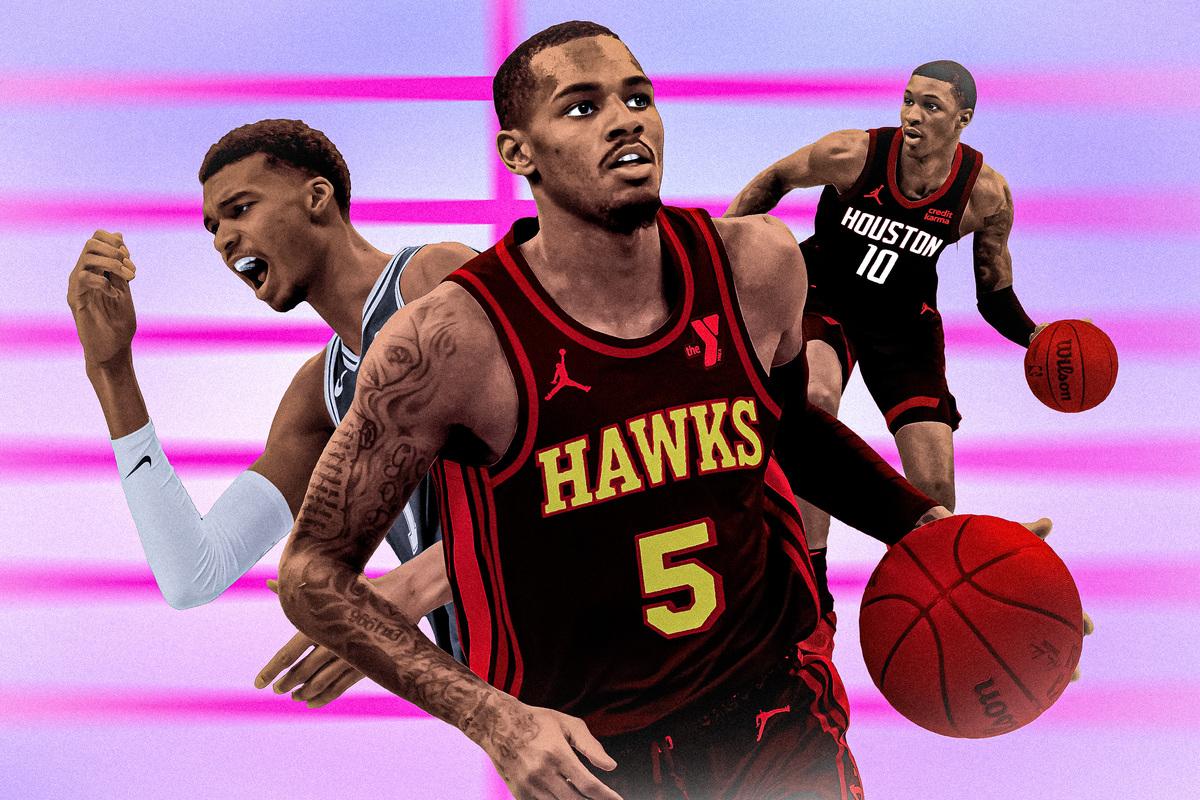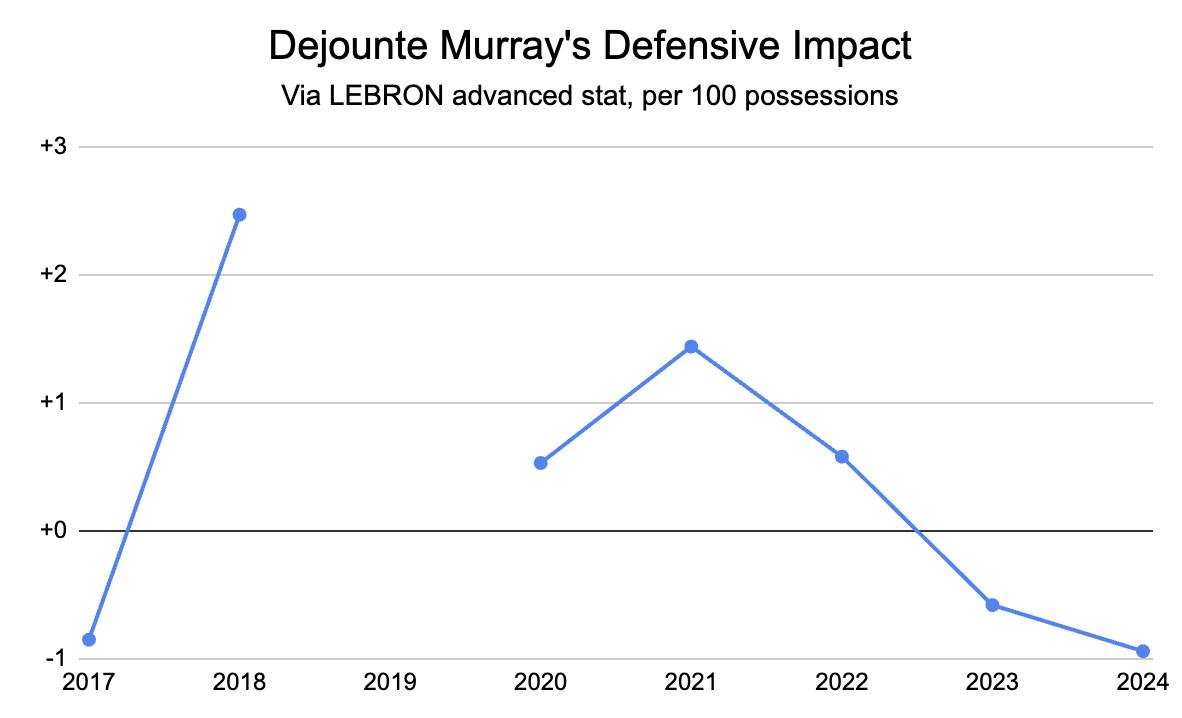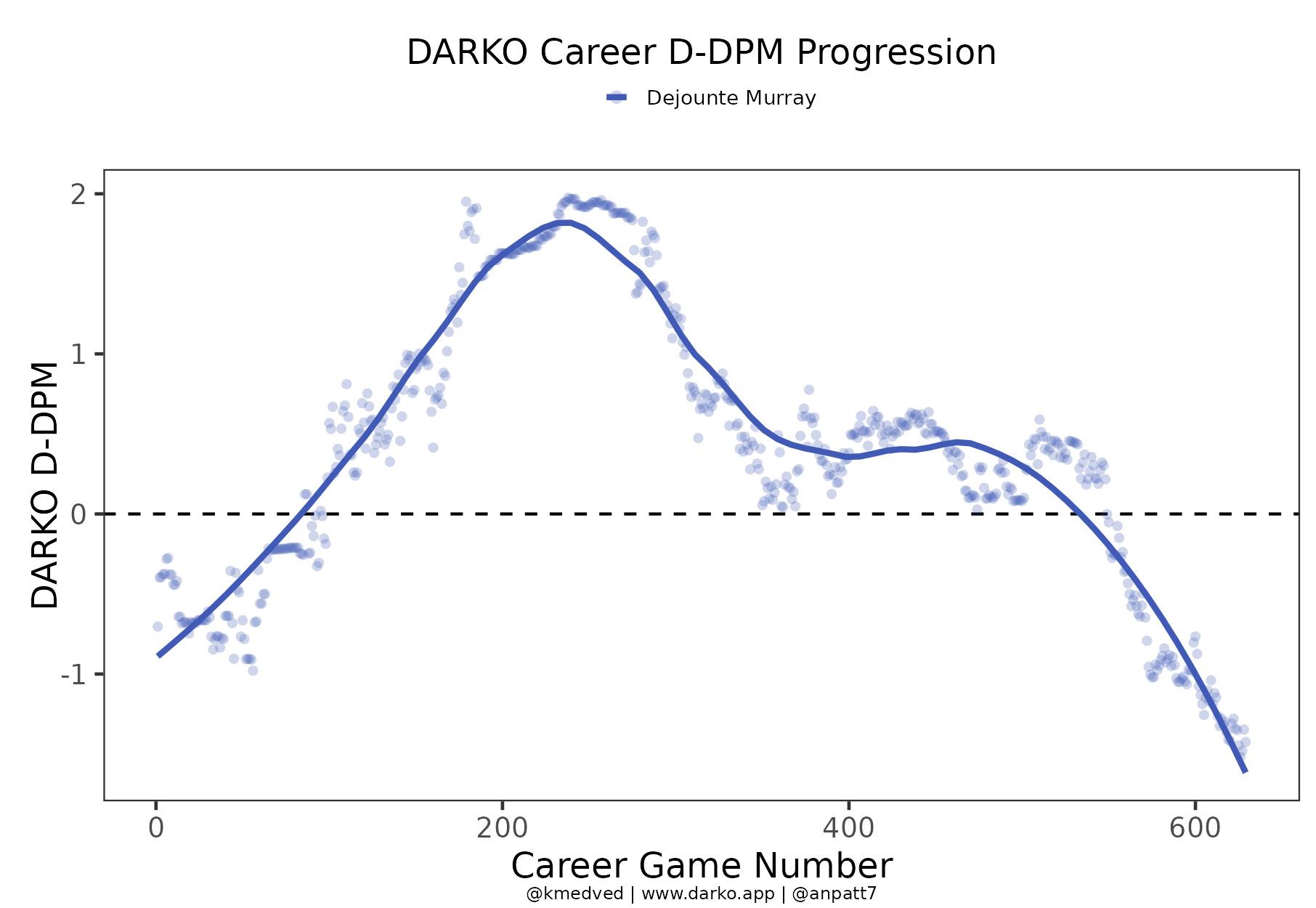
Each Wednesday of the NBA season, we’re analyzing a grab bag of topics from around the league. This week, we’re examining Dejounte Murray’s trade value, Victor Wembanyama’s surge at center, a fake 76ers trade, Jabari Smith Jr.’s underrated development, and more. This is the Kram Session.
Under Review: Just How Good Is Dejounte Murray?
It’s almost time for the trade spotlight to shine on the Hawks’ Dejounte Murray. As the Cavs and Jazz surge, Donovan Mitchell and Lauri Markkanen seem increasingly likely to stay with their current teams. Zach LaVine’s market remains frigid. And the Pascal Siakam sweepstakes might soon be over, as the Raptors and Pacers discuss a deal.
Meanwhile, the Hawks have fallen to 16-23, tied for 10th place in the East, and almost every player on the roster is available. Murray ranks second behind Siakam on The Athletic’s ranking of trade targets, and last week, Yahoo’s Jake Fischer deemed Murray the “most likely All-Star-caliber talent to be moved” at the deadline.
The question is whether the 27-year-old one-time All-Star, who is signed to a four-year, $114 million extension that kicks in next season, would be an actual difference maker on a better team.
The greatest concern about Murray is his current defensive level. He’s had the reputation of a lockdown guard since his second season, when he was so disruptive that he was voted to the All-Defensive second team despite playing just 21.5 minutes per game. Not many players are such good defenders with so little experience: Murray is one of just seven in the past 30 seasons to make an All-Defensive team as a rookie or sophomore, along with Tim Duncan (twice), Dwyane Wade, Patrick Beverley, Joel Embiid, Matisse Thybulle, and Evan Mobley.
He remained a top-tier stopper for years—even after missing all of his third season due to an ACL tear—and led the league in steals in 2021-22, when he made the All-Star team. That summer, the Hawks traded a trove of picks, including unprotected selections in 2025 and 2027 and an unprotected swap in 2026, for him, believing Murray could pair with Trae Young and push a fringe contender over the top.
I wasn’t a huge fan of that trade from Atlanta’s perspective, but even in my pessimism I thought Murray would help stabilize the Hawks’ lousy defense. Instead, he hasn’t made any noticeable impact on that end of the floor: Atlanta ranked 26th in defensive rating the season before Murray arrived and ranks 27th this season. Sure, he’s hampered by sharing the court with limited defenders like Young—but even when Murray plays without Young, the Hawks defense is among the league’s worst.
Get this: Since Murray joined the Hawks, their defense has been just as bad when Murray plays without Young as when Young plays without Murray, per PBP Stats. From a pure on-off perspective, Murray has had the same defensive impact as one of the league’s worst, smallest defenders. (To his credit, Young has noticeably improved his defensive effort this season.)
Hawks Defense With All-Star Guards Since Last Season
On-off numbers aren’t everything, but all the data agrees that Murray’s defense has regressed. In 2017-18, the advanced stat LEBRON ranked the young Spur as the top defensive guard in the NBA (minimum 1,000 minutes). In 2020-21, a full year removed from his ACL tear, he ranked fifth. But his defensive score has plummeted each season since.

It isn’t just one advanced stat. (Which is important, because defensive advanced stats are best viewed with a “wisdom of the crowds” approach.) Both box plus-minus and the DARKO system also view Murray’s current defense as the worst of his career.

Yet Murray needs to be an elite stopper because he isn’t a game-changing offensive player. On the plus side, Murray’s 3-point shooting has come around: A career 33.5 percent 3-point shooter entering this season, Murray’s up to 38.6 percent on a career-high six attempts per game in 2023-24.
But he’s never been a very efficient scorer and still struggles to find a rhythm off the ball. Even his career-best true shooting percentage this season is below the league average, in large part because he rarely gets to the free throw line. Over the past three seasons—which include Murray’s All-Star campaign—he ranks 49th out of 56 high-usage players in TS%. Most of the players behind him were rookies at one point during that stretch.
Worst True Shooting Among High-Usage Players, Past Three Seasons
Offensively, Murray is a good point guard in a league flooded with great point guards. That context compromises his market and potential fit on contenders: If his partnership with Young didn’t work, why would the 76ers or Knicks expect him to mesh any better with Tyrese Maxey or Jalen Brunson?
The Lakers offer a better fit because they don’t have a true entrenched point guard and LeBron James is the lead creator anyway. In theory, Murray could juice their sluggish offense while playing better defense with Anthony Davis behind him. But L.A. is stuck in a potentially tricky negotiating position with Atlanta: The Lakers likely view Austin Reaves as too valuable to trade for Murray, yet they don’t have enough assets to give Atlanta without including Reaves in a deal.
Murray could entice other bidders, too, with similar profiles. Both the Heat and Nets, like the Lakers, already have solid frontcourt foundations but desire a backcourt boost. But would those teams rather keep their picks to chase a bigger star, like Mitchell, instead?
Finally, one intriguing dark horse candidate is the Magic, who also have a strong frontcourt, and for whom any amount of competent point guard play would be a massive change of pace. The last Magic player to average at least 20 points and five assists per game was Steve Francis, 19 years ago. Orlando projects for copious cap space after this season but could slot Murray in and still have money left over for further summer upgrades.
Yet all those scenarios require Murray’s next team to buy into his All-Defensive potential and the belief that it can be recovered with a change of scenery. Because right now, with Murray looking like a decent offensive player and slumping defender, DARKO ranks him as a slightly below-average two-way player, next to the likes of Collin Sexton and Jordan Clarkson. Even if that rating seems overly bearish, it may be difficult for teams to justify trading multiple first-round picks for a player with that middling profile.
Take That for Data: Deadline Deals Rarely Sway the Title Race
Murray’s uncertain status as a championship game changer reflects the broader state of the trade market, with the deadline mere weeks away. Will any transaction before February 8 meaningfully affect the title race this spring?
Murray might not be a difference maker at his current level. LaVine might not be, either. And while Siakam is the best player who seems available for acquisition, he’s been linked mainly to the Pacers and other teams in the middle of the standings, like the Kings, Mavericks, and Warriors. None of them would enter the top tier of championship contenders even with an All-Star addition.
Meanwhile, analyzing the possible trade activity for the league’s best teams yields a similar conclusion: We’re unlikely to see a top contender make a big splash. The Bucks, Timberwolves, and Nuggets are already all in and have very little left to trade. The Clippers made their big move near the start of the season when they traded for James Harden. The Celtics and 76ers (and some of those other teams) are likely interested in depth upgrades, if anything. Only the Thunder, who at least outwardly seem hesitant to dip into their deep pool of future draft picks, might veer in a different direction.
That prediction might seem dispiriting, after a few years of hectic, star-laden deadline activity. Kevin Durant and Kyrie Irving were both traded last season. Harden and Ben Simmons were swapped in 2022. Harden was also a focal point of a midseason trade in 2021.
Yet as I’ve written before, deadline trades rarely result in immediate playoff success. Instead, championship rosters are built before the season; the best teams are typically already intact by February, without need for major upgrades. Only four championship teams this century have added a player via in-season trade who went on to average at least 20 minutes per playoff game:
- 2021 Bucks, with P.J. Tucker
- 2019 Raptors, with Marc Gasol
- 2005 Spurs, with Nazr Mohammed
- 2004 Pistons, with Rasheed Wallace
The deadline will still be noisy and flashy regardless. Trades are always fun! (Well, almost always: Last weekend’s Marvin Bagley III salary dump between the Pistons and Wizards strains the notion.) But barring a surprise turn over the next few weeks, the players who will most probably decide the 2024 championship are already in place.
Zacht of the Week: Wemby’s Unprecedented Production at Center
You’re forgiven if you’re not paying much attention to San Antonio: The Spurs are 7-32, and Victor Wembanyama is on a minutes limit after rolling his ankle during warm-ups in late December. He hasn’t played more than 27 minutes in a game or appeared in both ends of a back-to-back since then.
Yet amid that drudgery, there is reason for tremendous excitement about the no. 1 pick. On December 8, Spurs coach Gregg Popovich moved Zach Collins to the bench, thereby shifting Wembanyama from power forward to center. And the generational prospect has been extraordinary in his 15 games since.
Among all players with at least 200 minutes played since December 8, Wembanyama ranks 10th, with 27.8 points per 36 minutes. He’s fourth with 15 rebounds per 36. He leads the league with 5.2 blocks per 36. And he’s improved his efficiency, too, with performances like his triple-double in 21 minutes against the Pistons last week.
Victor Wembanyama’s Per-36 Stats
Even as his team toils at the bottom of the standings, Wembanyama is playing like a superstar without precedent. No previous player in NBA history has recorded at least 25 points and four blocks per 36 minutes over a full season. And Wembanyama is at 27 and five, plus a boatload of rebounds and assists, since the lineup change.
Two factors explain this surge, beyond general rookie adjustment to the NBA. First, the Spurs have also paired Wembanyama with a real point guard—finally!—who can feed him the ball in advantageous spots. Per PBP Stats, Wembanyama has a true shooting percentage of 61.3 when he plays with Tre Jones (about the same as Luka Doncic and LeBron James have this season), versus a TS% of 50.5 when he plays without Jones (about the same as Talen Horton-Tucker and Ausar Thompson).
And second, it allowed Wembanyama to play in more space, as he can get to the hoop—where, at 7-foot-4, he’s one of the league’s best finishers—without as much traffic. Since moving to a starting center role, Wembanyama has increased his rim attempts by nearly half, per Cleaning the Glass. He had nine dunks against the Hawks on Monday, tied for the most by any player in a game this season.
Victor Wembanyama’s Shot Distribution
Playing at center also elevates Wembanyama’s already prodigious defensive impact. He leads the league in blocks and looks like a clear future Defensive Player of the Year winner. Based on his last month of play at his best position, he looks like a clear future MVP, too.
Fake Trade of the Week: Gordon Hayward to the 76ers
To 76ers: Gordon Hayward
To Hornets: Marcus Morris Sr., Robert Covington, two second-round picks
It’s hard to construct a proper fake trade for Philadelphia. The 76ers could use another reliable playmaker, especially when Tyrese Maxey rests. But they also seem determined to save as much cap space as possible for the upcoming summer, so they might prefer to avoid trading for players on long-term contracts.
For instance, Hayward’s teammate Terry Rozier would fit in the 76ers’ backcourt—but Rozier is signed for two years and $52 million beyond this season. Malcolm Brogdon is another logical choice as a sturdy veteran who doesn’t fit on the rebuilding Trail Blazers—but he’s under contract for $22.5 million for next season.
Maybe Daryl Morey will decide to reduce his future financial flexibility and add the likes of Brogdon as a sort of “pre-agency” move, improving his team both this season and next. Now that Kawhi Leonard has signed an extension—with Paul George presumably to follow—next summer’s free agent class looks rather short on star power.
But if cap space remains a priority, Hayward would suffice as a jack-of-all-trades option on an expiring deal. The former All-Star is 33 years old now and has spent the past four years in obscurity—er, Charlotte—but he’s still a capable creator, averaging 4.6 assists per game this season, his highest mark in a decade. He can still shoot well enough (36 percent from distance) to play off the ball. And he’s still big enough to play next to Maxey and De’Anthony Melton on the perimeter and thus give 76ers coach Nick Nurse another option on the wing.
Moreover, compared to the likes of Siakam or Alex Caruso (if the Bulls begrudgingly decide to trade him), Hayward could probably be obtained for a much lighter return. He might even be a buyout candidate if Charlotte can’t strike a deal by the deadline. In this proposal, he’d fetch two second-round picks for the Hornets, which is more than they’d get by just buying him out. Morris and Covington—both of whom joined the 76ers in the James Harden trade—have expiring contracts and rank ninth and 10th, respectively, on the 76ers in minutes, so they’re easy inclusions to match Hayward’s salary.
Fast Breaks
1. Jabari Smith Jr. is living up to his draft slot
Three players were in contention for the no. 1 pick in the 2022 draft. Paolo Banchero ultimately went first, and he’s now an All-Star candidate who leads a playoff contender in points and assists. Chet Holmgren went second, and he’s playing like a Hall of Famer as a redshirt rookie. And then there was Smith, who went third to the Rockets and has since flown more under the radar, especially after his shot slumped early in his NBA career.
But Smith deserves a lot more attention for his play as a sophomore; he’s a budding 3-and-D standout on a Rockets squad fighting for a play-in berth. He’s exhibiting massive improvement on both ends. On offense, Smith shot 49 percent on 2s and 31 percent on 3s as a rookie; playing in a more structured offensive system this season, he’s up to 54 percent on 2s and 38 percent on 3s.
Playing next to established veterans, fellow lottery picks, and breakout star Alperen Sengun, Smith still sits fairly low in the Rockets’ offensive pecking order. His usage rate ranks just eighth among the team’s rotation players. Yet his defensive surge is even more impressive, as the 20-year-old, 6-foot-11 Smith has used his length and physicality to disrupt scorers across the positional spectrum.
“He starts at the 4 guarding a lot of small-ball 4s, but we can switch him down to the 3 or switch him onto 5s,” Rockets coach Ime Udoka said in Chicago last week, after Smith spent much of crunch time isolated on DeMar DeRozan. “He gives us versatility with his length. It’s just a matter of getting those matchups under his belt.”
Udoka has used Smith on dangerous wings even more frequently of late, as Dillon Brooks and Tari Eason have missed time with injuries. Smith is a strong rebounder, averaging nine boards per game, with five double-doubles in the past month. And the second-year player believes that as he gains more experience, he’ll continue to improve and learn the intricacies of each frontcourt position.
“I think that’s one of my strong suits,” Smith said of his growing versatility. “I think as a rookie, I couldn’t guard, I couldn’t be matched up on [Nikola] Vucevic, I couldn’t be matched up on [Andre] Drummond, those type of guys, so I think it’s definitely an improvement from last year.”
2. When will Jamal Murray make his first All-Star team?
Murray is a defending champion, a proven playoff dynamo, and one of the 20 best players in the NBA. He also might be Mike Conley’s successor as the best active player to never make an All-Star team. (CJ McCollum has a strong case as well.) Yet even though Murray is enjoying his best regular season to date—including a career-best 41 percent 3-point mark and 6.4 assists per game—that status seems unlikely to change next month.
Murray’s problem is that he missed nearly all of November with a hamstring injury, and the Western Conference guard pool is so crowded that his playing time falls short compared to that of his competitors. Shai Gilgeous-Alexander, Luka Doncic, Anthony Edwards, and Steph Curry all have at least 400 more minutes than Murray. De’Aaron Fox and James Harden are ahead by more than 300 minutes. And Devin Booker has him beat by more than 250 minutes.
That’s seven extremely worthy guard candidates—already too many to fit on an All-Star roster before considering Murray (or Kyrie Irving, whose playing time is similar to the Nuggets guard’s). Conley had to wait until he was 33 years old to finally become an All-Star, and McCollum is 32 without any appearances; let’s hope that Murray, who will turn 27 next month, doesn’t have to wait nearly as long.
3. Rookies Scoot Henderson and Brandon Miller are having a tough go
Let’s file this entry in the annals of: It takes time for even highly touted prospects to find their footing in the NBA. By box plus-minus, the worst qualified player this season is no. 3 pick Scoot Henderson, at minus-7.8 points per 100 possessions. And fifth from the bottom is no. 2 pick Brandon Miller, at minus-5.1.
That doesn’t mean the two rookies are busts or doomed forever—though their teams would certainly prefer more consistent signs of promise. Rather, it’s another sign that most rookies struggle a lot in their first exposure to the NBA, so let’s gawk at Victor Wembanyama and Chet Holmgren—two rookies who are thriving—even more.
4. The Warriors’ 2022 title feels light-years away
On that note: Third from the bottom on this season’s BPM leaderboard is Jordan Poole, at minus-5.9 points per 100 possessions. And fourth from the bottom is Andrew Wiggins, at minus-5.8.
For reference, Kevin Durant and Kawhi Leonard are both at plus-5.9 this season, meaning Poole and Wiggins have been as bad as Durant and Leonard have been good.
Maybe, in retrospect, let’s gawk at the Warriors’ 2022 title, of which Poole and Wiggins were crucial components, even more.
Statistics through Monday’s games.


